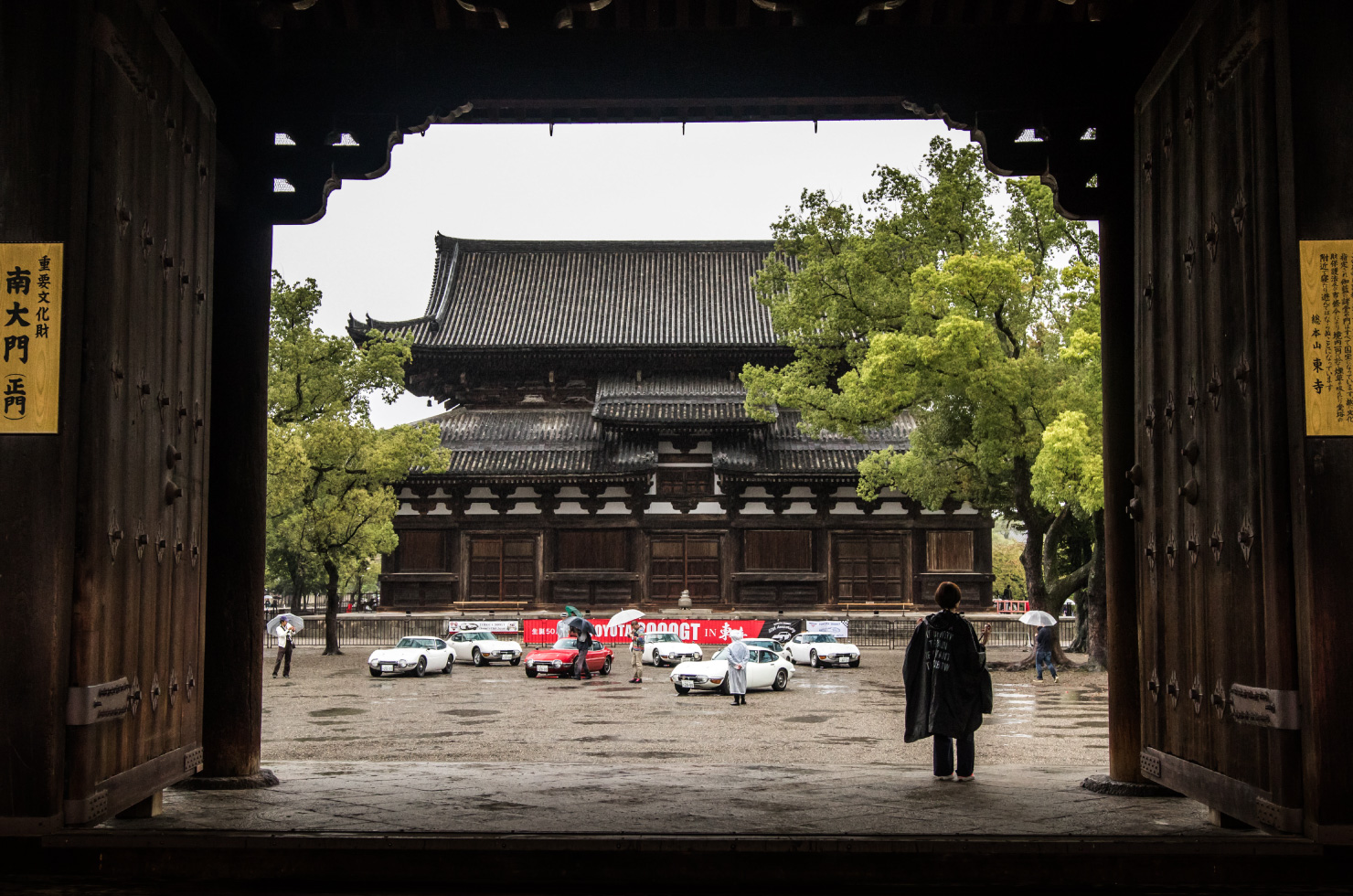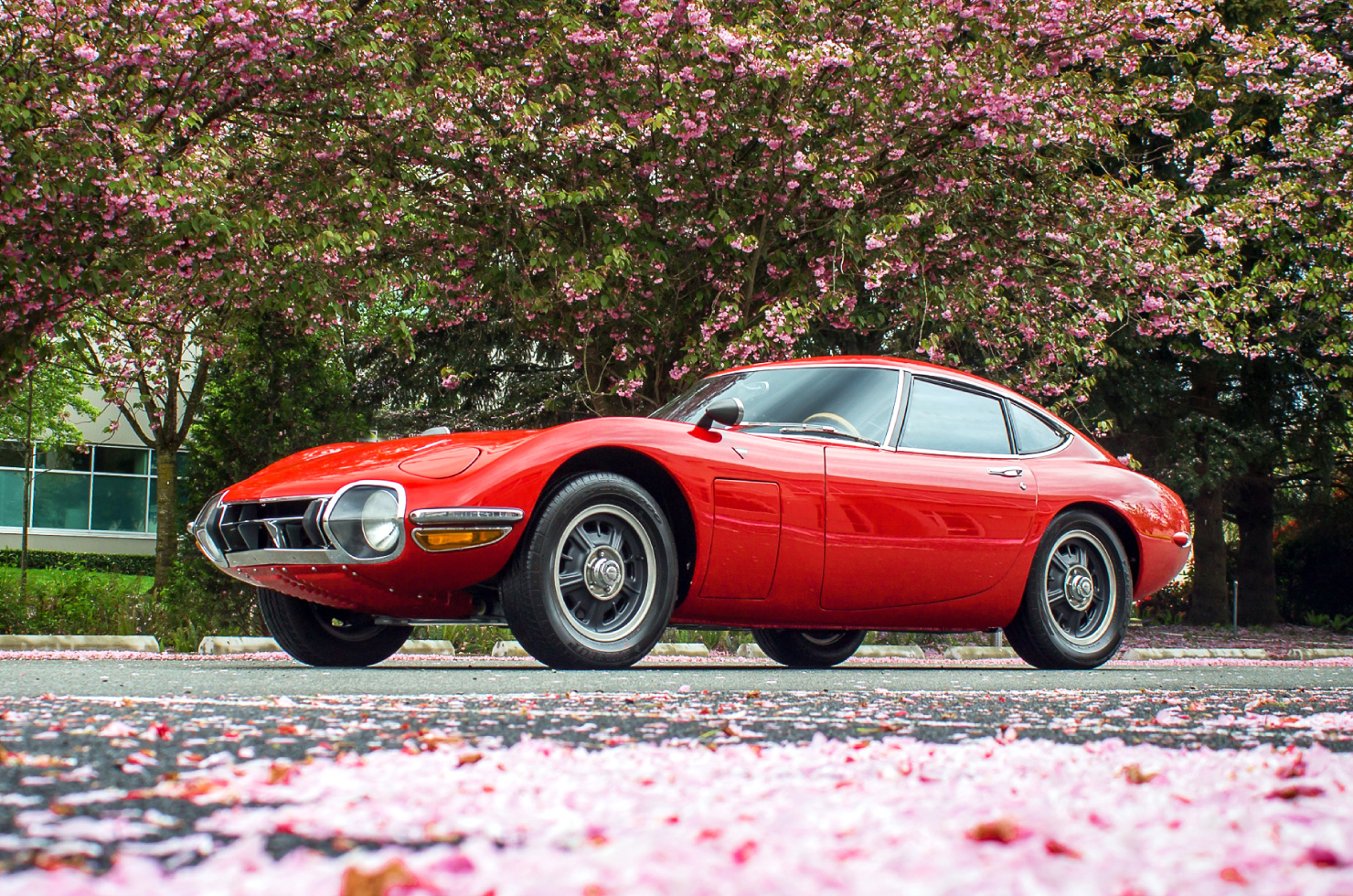Chosen as the seat of the Imperial court in the year 794, Kyoto remains, for many, the cultural capital of Japan. It is a city of temples and art, narrow streets following old pathways and broad plazas where people flock to celebrate the country’s heritage.
On this occasion, holding umbrellas to ward off the rain from the tail of a dwindling typhoon, visitors come to pay tribute to the most special car ever built in the Land of the Rising Sun. Seven hand-built coupes, six white and one red, sit proudly in front of a temple that dates back more than a millennium. They were made by Toyota, a brand known outside Japan for ubiquitous reliability, not beauty, and as the country’s largest manufacturer. Toyotas are everywhere, from the Prius that picked you up at the airport to the hand-me-down Corolla you drove to university. Dependable, yes, but deserving reverence?
The Toyota 2000GT, on the other hand, is a different beast. In March 2022, a 1967 model prepared for the SCCA racing series in the U.S. sold at auction for a staggering $2,535,000 (U.S.), easily the most ever paid for a Japanese classic car. Even an ordinary 2000GT, if you can call any of the just 357 made “ordinary,” is worth more than a million dollars today. And for good reason.
In 1965, when the 2000GT made its debut at that year’s Tokyo Motor Show, the Japanese automotive industry was seen as the producer of cheap, disposable little boxes. You could buy a Toyota in Canada in the mid-’60s, but only something basic like a Corona (ancestor to the Corolla) or the even slower 28-horsepower Publica. Yet here was Japan building a machine that could rival the desirable Jaguar E-Type. With smooth inline-six power and classic grand tourer styling, the 2000GT put the world on notice: Japanese cars had arrived. But where had this gorgeous machine sprung from?
In fact, the 2000GT was not built by Toyota but by Yamaha. Founded as a piano maker in 1887, Yamaha began producing airplane parts during the Second World War. After the war, two-wheel transportation was essential to the country’s rebuilding, and Yamaha’s metallurgical expertise dovetailed nicely with motorcycle manufacturing. On the heels of this success, the company formed an automotive partnership with Nissan. A secret project car called A550X was produced, but the Nissan-Yamaha partnership fell apart. Instead, Yamaha approached Toyota, which was looking for a flagship vehicle to raise public perception of its brand. Toyota moved a hand-picked team of designers and engineers into Yamaha’s research centre, and work began immediately.
The production 2000GT would not arrive until May 1967, but it arguably achieved its greatest impact even before the first example was sold. After wowing the crowds at the 1965 Tokyo Motor Show, Toyota set about establishing its new flagship’s bona fides at the recently constructed Yatabe oval course. Here, in 1966, over 72 hours of continuous high-speed lapping, the 2000GT set 16 international speed and endurance records.
Experiencing this car first-hand is a chance to get up close and personal with Japanese automotive royalty.
Mechanical achievement was followed by movie magic—a convertible 2000GT took a starring role in the 1967 James Bond film You Only Live Twice. Filming took place in 1966, and on finding Sean Connery’s six-foot-two frame too tall to fit in the low-slung coupe, Toyota sliced the top from two white 2000GTs. Both cars still exist, one in the hands of a private collector, the other in the Toyota Automobile Museum.
Besides prototypes, Toyota built 218 2000GTs for the Japanese domestic market and 102 for export. Fewer than a third were left-hand drive, but one of those, a 1967 model, made its way to Vancouver courtesy of the president and CEO of the OpenRoad Auto Group, Christian Chia. In past years, it has been featured at the Vancouver Auto Show.
Experiencing this car first-hand is a chance to get up close and personal with Japanese automotive royalty. Parked beneath the cherry blossoms—another Japanese import to Vancouver—the 2000GT is stunning. The quality of the handmade aluminum body is impeccable, obvious care taken by the craftsmen who built it. Details abound, like the plexiglass-covered driving lights and louvres under the front bumper. The cabin is a tight fit, as the car’s roof sits just 45.7 inches above the pavement. Nevertheless, it is a gorgeous place to be, with wood veneer carefully laid out by Yamaha’s experienced piano artisans.

The company’s metallurgical experts also plied their trade on the 2000GT’s engine, a stout inline-six taken from the Japanese-market Toyota Crown executive sedan. Building on the straight-six’s balanced layout, Yamaha created a twin-camshaft, all-aluminum head that allowed for 150 horsepower, modest by today’s standards but ample for the time. Being a Toyota, the engine of course fires on the first turn of the key.
From behind the wheel, the experience is overwhelmingly smooth. A contemporary E-Type has more torque and a whisky-voiced growl to the engine, where the 2000GT’s smallish two-litre engine whirs up to speed. Driving on the streets of Richmond, the 2000GT feels modern, well balanced, and fitted with excellent brakes. Because they are such valuable cars, few 2000GTs are regularly driven, but they would be ideally suited to grand touring. At the time it was built, it must have been a shock to the world that the Japanese car industry could produce such a well-sorted machine.
In the current day, the shock is that such a rare and expensive car feels so usable. It’s not a high-strung exotic like a contemporary Maserati or Ferrari but a well-engineered and beautifully constructed machine. The Datsun 240Z that followed a few years later democratized the idea of a Japanese sports car as a more affordable effort, but the 2000GT was the very best car Japan could build at the time.
By a measure of sales, the 2000GT was not a success. Further, the SCCA-spec racing model mentioned earlier was handicapped by a rule change regarding permissible carburetors and finished third behind some Porsches.
The 2000GT would neither make financial sense nor achieve racing victory. Still, half a century on from its debut, it remains head and shoulders above every other Japanese classic car. It was a pioneer, heralding performance heroes like the Supra and the Lexus LFA. It was a country’s first automotive salvo, to be followed by decades of plucky, lovable Datsuns, Hondas, and Toyotas.
The Toyota 2000GT is rolling art. Sketched out like flowing calligraphy. Handcrafted by Yamaha’s most skilled takumi. An automotive jewel still prized above all else as the pride of Japanese automotive manufacturing.
Read more from our Spring 2023 issue.









